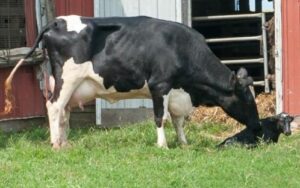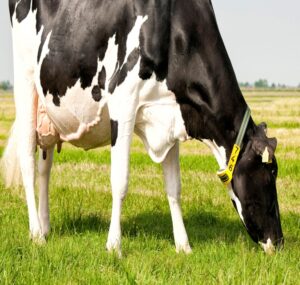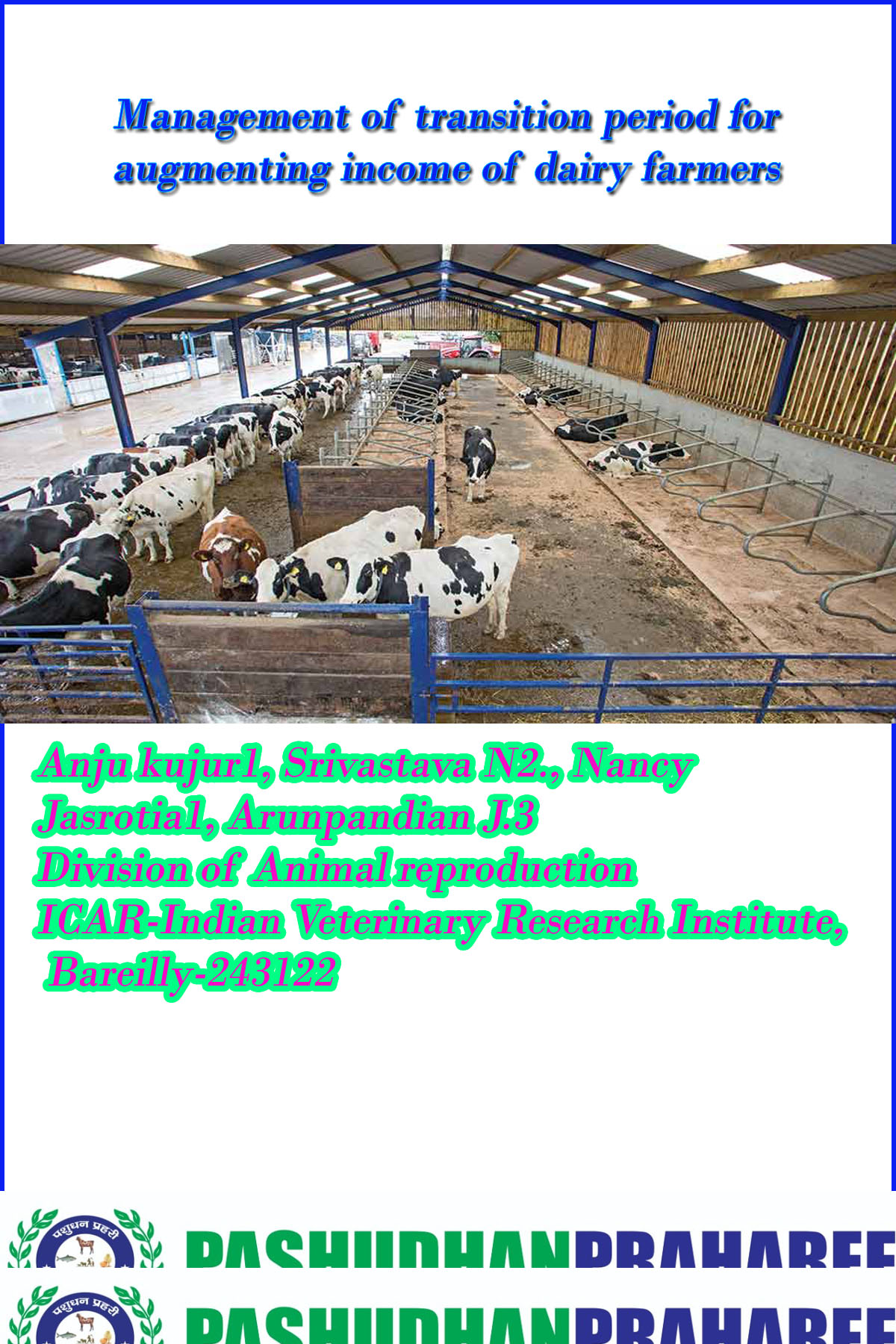Management of Transition Period for Augmenting Income of Dairy Farmers
Anju kujur1, Srivastava N2., Nancy Jasrotia1, Arunpandian J.3
Division of Animal reproduction
ICAR-Indian Veterinary Research Institute, Bareilly-243122
______________________________________________________________________________
Dairy farming serves as a vital contributor to the economy of dairy farmers. To get optimum benefits from the dairy farming management of the transition period is very important. The period of change from the pregnant, non-lactating state to the non-pregnant, lactating state via an interval from three weeks pre-partum to three weeks post-partum is defined as the transition period of a dairy cow. Any aberration in the successful transition puts the dam susceptible to metabolic and infectious diseases resulting in diminished milk production, lessens the reproductive performance and hence adversely affects the overall profitability to the dairy farmers. Proper management with good strategies of feeding with adequate diet, mineral and vitamins supplementations reduces the risk of contracting certain diseases which might otherwise gain upper hand during transition period.
______________________________________________________________________________
Keywords: transition period, metabolic diseases, management, cows

Cow with calf at heals |

Dry cow
|
For doubling farmers income dairy farming plays an important part either as a sole venture or as a zero management supplementary enterprise. In either way it is imperative to scientifically manage the various stages in the life cycle of dairy animals, most importantly the transition period. Scientific management of the transition period enhances the productivity and profitability and optimizes the return on investment to the dairy farmers. Moreover, the transition period is extremely important as it determines the future health, daily and the total milk yield and reproductive performance of the dairy animals. The duration of transition period ranges from three week before calving to three week after calving (Figure 1); a period marked by transition from dry period to the production (milking) stage (dry cow-3 week pre-partum; peri-parturient period- 2-3 days around calving; and fresh cow-calving to three week post-partum). This period is critical and challenging for the dam as well as for the dairy farmers because the pregnant dam undergoes various physiological and biochemical changes. Such changes make pregnant dams more susceptible to various metabolic (ketosis, fatty liver, acidosis, milk fever) and infectious diseases (mastitis, metritis, pyometra, and retention of placenta etc) leading to capital loss to dairy farmers. All dairy cattle at pre-partum period experience a period of insulin resistance, reduced feed intake, negative energy balance, lipolysis and weight loss in early lactation; hypocalcemia, immune-suppression and bacterial contamination of uterus at post-partum. All such dramatic changes are contributed by the circulatory changes in the progesterone, estrogen and glucocorticoid concentration. The transition period renders a censorious life phase in buffalo also. Buffalo shows contrasting pattern of metabolic response to lactation compared to other ruminants by less occurrence of metabolic disorders. However, in buffaloes ketosis is primary condition responsible for diminished milk yield. The loss in productivity arising out of detrimental effect of varying physiological status of pregnant dam can be successfully avoided by scientific management of the transition period as detailed below.
Figure 1: The duration of transition period
Metabolic and physiological adaptation during transition period
The peri-parturient period in animals is characterized by intense endocrine and metabolic changes to achieve the milk production throughout the lactation. Following calving, for the initiation of milk synthesis and marked increment in milk production profound energy is required. But the total intake of energy after calving is usually less than energy required leading to negative energy balance (NEB). During the term of NEB, the hormones and tissue response in alteration of increase lipolysis and reduce lipogenesis give rise to blood levels of non esterfied fatty acid (NEFA) and β hydroxybutyrate (BHBA). An increment of NEFA and BHBA is the metabolic distinctive features of transition from pre-parturient to lactation .However an excessive increment of these metabolites is correlated with substandard productive and reproductive performance. Though the NEFA in the blood furnish energy to the tissue however bovine liver has a restricted capacity to metabolize NEFA into Triglycerides (TAG). Thus, the TAG is accumulated in liver, and further acetyl CoA is not utilized in tricarboxylic acid cycle and is converted to ketone bodies (acetone, acetoacetate and BHBA) appearing in blood, milk and urine. Animals with increased lipolysis are at high risk to develop fatty liver syndrome. The development of fatty liver, impairs the gluconeogenic activity, which lessen blood glucose and reduce insulin secretion which supports greater lipid mobilization and marked increment in fatty acid uptake by liver increasing ketogenesis (Figure 2). A reduction of energy requirement and nutrient intake leads to numerous metabolic disorders (fatty liver, ketosis, ruminal acidosis and milk fever).
Along with several hormonal changes, alteration in growth hormone during early lactation stimulates gluconeogensis in liver to enhance supply of glucose. At the same time, GH creates insulin resistance preventing utilization of glucose by liver, muscle and adipose tissue and stimulate lipolysis which mobilize fatty acids for the production of milk fat synthesis. Inadequate glucose leads to incomplete or partial oxidation of NEFA which increases ketogensis. At calving, plasma progesterone level drops down rapidly and is accompanied by the increment in the estrogen and glucocorticoids contributing to the decline in dry matter intake (DMI) and promote the mobilization of body fat reserve from adipocytes.
Immune status of dairy cow is depressed in or around parturition. In transition period there is marked increment in level of blood cortisol level from 4-8 ng/mL to 15-30ng/mL which depress both humoral and cell mediated immunity (Figure 2). Thus, phagocytic and bacteriocidal ability of blood polymorphonuclear cells is depressed during late gestation. Lymphocyte proliferation is higher but antibody production ability response to mitogens decrease significantly at one week pre- and post-partum. The cortisol concentration is only transitionally elevated but variation in level of plasma estrogen and progesterone at time of parturition also contributes to immunosupression. However NEFA and BHBA metabolites which increase in NEB are also responsible for suppression of immune response. Rumen disorders and inflammatory condition in uterus are typically associated with reduced DMI, thus enhancing the susceptibility of animal to infections such as metritis or mastitis during early postpartum periods. (Figure.2). All the metabolic and infectious disease are interlinked with the NEB and immunosupression (Figure.3)
Figure 2. Peripartal adaption of the key tissue such as liver, mammary gland, adipose tissue, rumen, uterus, brain as well as the immune system.
Figure 3. Complex interrelationship of transition cow disease
Mismanagement of transition period increases probability of metabolic diseases
Dairy animal that fails to adapt the metabolic and physiological changes may develop majority of post-partum diseases (upto 65% of them). The production and reproductive disorders occurring during the transition period are divided into 3 principles axes (Table.1). The metabolic and infectious diseases after calving may exceed the industrial targets and acceptable thresholds requiring attention especially within 14 days of calving (Table.2).
Table 1. Classification of production and reproductive disorders
| Principles | Disorders |
| Disorders related to energy metabolism | Ketosis, Fatty liver, acidosis and Displaced abomasums |
| Disorders related to mineral metabolism | Milk fever, hypophosphatemia, Hypomagnesimia |
| Disorders related to immune system | Mastitis, metristis , pyometra and retention of fetal membrane |
Table 2. Cow health problem (expressed as percentages of case calving cows within 14 days of calving)
| Health problem | Target | Seek help if |
| Milk fever | 1% | >3% |
| Clinical ketosis | <1% | >2% |
| Abomasal displacement | <1% | >2% |
| Clinical mastitis | <5cases/ 100 cows /first 30 days | >5cases/100 cows/first 30 days |
| Lameness | <2% with >score 2 | >4with >score 2 |
| Hypomagnesaemia | 0% | 1 case |
| Retained placenta | <4% | >6% |
| Clinical acidosis | 0% | 1% |
Managemental interventions proposed
The main purpose of nutritional and environmental management during the transition period is to maintain or enhance the immune function, minimize the extent of body fat mobilization around calving, maintain the blood calcium pre- and post-partum and maximize the appetite of the cow before and after calving. This leads to marked increment or enhancement of the economy of the farmers resulting in high milk yield, profitability and return in investments. Since dairy cows has different requirements in each phase for optimal management the transition period is divided into
- a) Far-off dry period
This is the duration from drying off to 21 days before calving when there is no milk production with rapid growth of fetus. Though this stage is not included in the transition period but it is important to set the stage right for these cows before they make that transition back into the milking herd. The key, in this stage, is to maintain a balanced diet with adequate energy without leaning towards excess. Following points may be considered
- Provide diets which contains about 1.32Mcal/kg -1.39Mcal/Kg of dry matter with at least 12% crude protein (Table.3)
- Provide adequate energy-rich diet by feeding with wheat straw or high neutral detergent fiber grass hay along with the adequate quantities of corn silage and grain.
- Add appropriate amount of trace minerals and vitamins such as selenium (0.3 ppm in total diet) and vitamin E (1000 IU/day for dry cow and 500 IU/day for lactating cow) maintain immune function (Table.3)
- Measure the body condition score throughout the dry period (optimum range 3.0 – 3.25 on scale of 1 to 5 (Table.4)
- Provide heat abatement measures to reduce heat stress like providing shade trees.
- Allow adequate exercise to reduce the risk of displaced abomasums (DA) since non- exercised cows have a high risk of calving related diseases, mastitis and leg problem.
- Strive for individual feeding as pregnant dams do not compete well for feed bunk space limiting their intake at critical phase and increasing the incidence of metabolic disorders.
- b) Close-up dry cows
It is the duration of last 7 to 14 days before calving when there is decrease in dry matter intake up to 10-30% whereas nutrient requirement remains high. Maintain feed intake prior to calving as it can be impacted after calving when energy demands are high, which is directly correlated with the milk production. The Body condition score should not be greater than 3.5 in last three weeks of calving as such animals have a greater chance of depression in feed intake compared to those with lower BCS.
- Supplement low potassium with adequate quantity anionic salts to reduce the chances of clinical and sub clinical milk fever.
- Check the calcium status of cow at calving and monitor the effectiveness of an anionic ration. Provide recommended level of Magnesium (Mg) concentration in diet @ 0.45% before and after caving. Ensure feeding of calcium, phosphorus, vitamin E and selenium.
- Control phosphorus concentration before calving to <0.4% after calving as increasing phosphorus concentration increase milk fever risk.
- Supply enough forage to fill rumen and encourage cud chewing (2-3 kg of long stem hay or straw per cow).
- Allow the animal to eat before calving.
- Check body condition score which should be 3.0 to 3.25. Animal with score of more than 4.25 are more susceptible to adverse conditions listed above (Table 4)
- Minimize heat stress by using fans and sprinklers.
- Addition of feed additives like rumenish yeast or protected choline helps in mammary gland development and also prevents metabolic diseases.
- Maintain the body weight of dry cow during the last 2-3 weeks prior to calving. Loss of weight in this phase leads to accumulation of excessive fat in the liver predisposing them to fatty liver syndrome.
- c) Fresh cow
Fresh cows are cows after calving. After calving, it is a critical period in which animals are in negative energy balance, using their stored energy to produce milk even not consuming enough feed to provide the energy that they need. Management practices aim to enhance the dry matter intake, increase the energy density without influencing rumen function. The diet changes sharply at calving from forage based to more concentrate–rich diets. This provides enough energy to prevent the cow from metabolic and reproductive complications.
- supplement enough glucose and calcium propionate at the rate of 100 g per day which enhance the blood glucose level and decreases the blood ketone levels. Commercial supplements include sweet lac transition®, neutral cal®, for three weeks pre- and post-calving.
- Use specific amino acid to enhance the movement of fat from the liver thereby improving the liver function and increasing the dry matter intake. The dietary crude protein should be 19% for fresh cows.
- Supplement rumen protected choline commensurate with increase in milk production
- Observe the animal frequently to make sure they are eating to avoid metabolic complication.
- Addition of adequate fat supplements such as roasted soya beans, sun flower seed, or whole cotton seed benefits at decreasing body weight.
- Use dietary buffers which induces early lactation in animals that are off feed or experiencing low DMI such as sodium bicarbonate at the rate of 50-100 g per cow per day.
- Do not house fresh cow with sick animals, with the stocking rate near 80% in free stalls.
- Provide adequate bunk space ranges from 18 to 30 inches per cow.
- “Cow comfort” is essential for the productivity which includes adequately sized and easily accessible stalls and dry clean environment.
Table 3. Recommendation for transition cow diet on the basis of dry matter
| Nutrients | Far –off dry cows (more than three weeks pre calving ) | Close up dry cows(last three weeks pre- calving) | Fresh cows ( first weeks of post calving ) |
| DMI | 1.75-2 | 2-2.5 | 3-4 |
| Crude protein (CP) % | >12 | 14-16 | 16-19 |
| Calcium % | 0.4 % | 0.4-0.6 % | 0.8-1.0 % |
| Phosphorus% | 0.25 % | 0.25-0.4 % | 0.4 % |
| Magnesium % | 0.3 % | 0.45 % | 0.3 % |
| DCAD Meq/Kg | <150 | <80 | >250 |
| Selenium mg/kg | 0.3 | 0.3 | 0.3 |
| Copper mg/kg | 10 | 15 | 20 |
| Cobalt mg/kg | 0.11 | 0.11 | 0.11 |
| Zinc mg/kg | 40 | 48 | 48 |
| Magnaneses mg/kg | 12 | 15 | 15 |
| Iodine mg/kg | 0.6 | 0.6 | 0.6 |
| Vit A IU/g | 2000 | 3200 | 3200 |
| Vit D IU/g | 15 | 30 | 15 |
Table 4: Target BCS for dairy cattle at different points of the lactation cycle
| Stages of lactation cylcle | Scores(1-5 scale) |
| BCS at drying off | 2.75 -3.0 |
| BCS at calving | 3.0-3.25 |
| BCS at 42 days in milk | 2.75 minimum |
| BCS at breeding | 2.75 minimum |
| BCS at late lactation | 2.75-3.25 |
90% of the herd should meet these targets
SUMMARY
With the increasing herd size along with increase in the number of high yielding cattle in India, regular assessment of dairy herd performance has become an important part of dairy farming. This is much more important since such exercise assists in doubling the farmer’s income. In this process scientific management of the transition period is of utmost importance for, at this period the dam undergoes enormous metabolic and physiological changes. Such physiological stress places dams more prone to the metabolic or infectious diseases. Adequate nutrition and feeding management, supplementation of succulent forages and adoption of management practices like proper body condition score, and maintenance of Far-off dry cow reduces the complication of close-up dry cow and fresh cow. This helps the farmers obtains healthy calf after calving and increment in milk yield, with great reduction in the treatment cost of animal. Adoption of such recommended practices in transition period management of a dairy cow is a prerequisite to achieve and exploit maximum economic gains for doubling farmer’s income and optimize reproductive performance of a dairy cow. Moreover, it helps in achieving welfare goals of an animal.
1Phd scholar, 2Principal Scientist, 3MVSc scholar, Division of Animal Reproduction, ICAR-IVRI,Bareilly,(U.P); corresponding author:anjikujur007@gmail.com
https://en.engormix.com/dairy-cattle/articles/nutritional-management-transition-cow-t33343.htm


